TABLE OF CONTENTS
As cannabis consumers and growers become more familiar with the cannabis plant and gain familiarity with a higher number of marijuana strains, most of them develop personal favorites and enjoy their unique flavors and effects.
Like produce and natural food consumers, cannabis enthusiasts want to use strains and products made from natural, healthy sources – and organic compost may just be the best choice for purely organic marijuana cultivation. There are a handful of benefits of growing cannabis with compost.
Growing Organic Cannabis
Organic fruits and vegetables, as well as grass-fed beef and free-range chicken are now readily available and continuing to gain popularity. These higher-quality foods not only taste better but are healthier for those who eat them compared to processed food products.
Health-conscious consumers want their food to be as natural as possible, with humanely raised animal protein, free of growth hormones and additives.
Because of this understandable preference for sustainable and healthier food alternatives, it should come as no surprise that many cannabis users would prefer organically-grown cannabis as well instead of cannabis grown with synthetic fertilizers.
The flavors and aromas of organic cannabis are far superior to its counterpart grown with synthetic fertilizers and chemical soil additives.
Some cannabis connoisseurs can actually taste the tell-tale flavors and smell the aromas of synthetic fertilizers that sometimes linger in cured dried flower, especially if it wasn’t properly flushed prior to harvestor cured and dried.
So, how do you grow better cannabis that doesn't use dubious ingredients?
The answer: You use compost to give your plants naturally-derived nutrients that are slowly released for better root absorption.
Compost vs. Bottled Soil Amendments
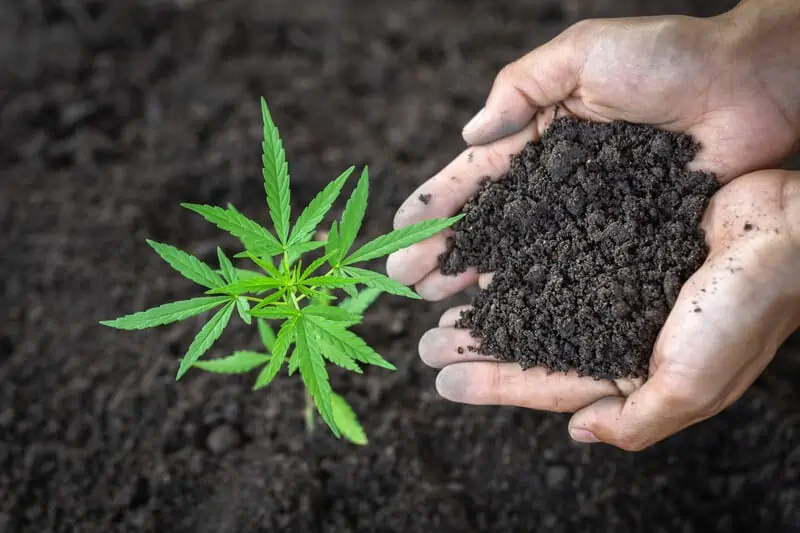
When growing cannabis, many commercial and home growers decide to use organic cultivation practices for a variety of reasons. The more they grow weed, the more they want to learn about organic approaches to cannabis farming to improve their yield and bud quality. It’s only natural.
The best way to improve your bud’s quality is to use organic, compost-amended soil supplemented with organic fertilizers. Basically, avoid synthetic alternatives as fertilizers and soil amendments.
There are some outstanding organic soil amendments and additives sold in bottles in most nurseries or on the internet, but using these synthetically-derived products exclusively will not necessarily result in excellent soil or buds.
Because cannabis does best with a wider range of nutrients during its different stages of growth, compost-supplemented soil provides an excellent balance you simply can’t bottle and sell.
Many brands of bottled fertilizers combine three or more different bottled fertilizer products to be fed in varying ratios during the vegetative, flowering, and pre-harvest stages of the cannabis lifecycle.
This approach is not as purely organic as using compost as part of the cultivation method—although many growers dismiss the difference and choose to go with bottled recipes for valid reasons like simplicity and convenience.
Other growers believe that a superior approach is using compost-amended soil and a more conservative fertilizer regimen or one without synthetic fertilizers.
The Benefits of Growing Cannabis with Compost and What is it?
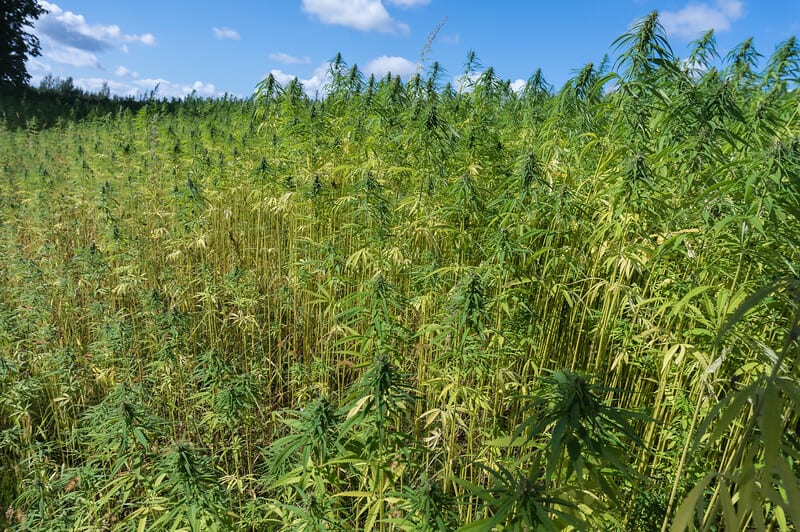
Simply stated, compost is decomposed organic matter. Compost can be made with a wide range of ingredients in a variety of ways. Over time, the materials used for compost break down and create a stable compost pile.
Those who create their own compost recycle leaves, grasses, and vegetable matter and scraps into a black, rich soil amendment, known as ‘humus’, that plants thrive on.
The growing benefits of compost and the way it makes plants perk up and hit their peak earns it the name “black gold” among an appreciative group of gardeners, as well as home and commercial cannabis growers.
Not only does compost significantly improve the taste and smell of your cannabis, but it is a great way to return organic nutrients back into the soil.
Here's a rundown of the top benefits of growing cannabis with compost:
- Significantly improve the quality of your soil
- Add organic nutrients to the soil that naturally and slowly release for better nutrient intake
- Includes macro and micronutrients that may not be found in synthetic fertilizers
- Reduces synthetic fertilizer runoff to waterways
- An affordable way to feed your plants nutrients compared to costly synthetic fertilizers
- Improve the soil structure allowing the root system to grow and absorb nutrients
- Balances the soil's pH which improves plant growth
- Reduces the risk of pests and disease
- Improve moisture retention of soil which requires less watering
Buying Commercial Compost
One way to obtain compost is to buy it at a garden nursery or order it online. Bagged compost can be expensive if you have a large garden, but for people not able to conveniently create their own, it’s an available option, and more affordable when bought in bulk.
There are a variety of organic compost mixes available from a wide choice of suppliers. Compare bagged compost prices and the quality to ensure you’re getting the most bang for your buck without compromising on quality.
All compost is not created equal, so if you choose to buy it, research ingredients and online reviews from those who have first-hand experience with the available brands and products.
Make sure the raw materials are organic or else you won't reap the full benefits of composting. Also, make sure they are pesticide-free.
Like any consumer product, quality can vary. You want the very best for your cannabis grow, so doing your research on the company and product before purchasing will help ensure you get the best possible results.
A good rule of thumb when buying compost is to smell the product before buying it, if possible. If it smells like ammonia, it is not a mature compost. It won't effectively give your plants the nutrients it needs. Make sure your compost is dark and fluffy soil. Looks and smell matter.
Avoid any compost-based soil mixtures that contain any synthetic fertilizers as a supplement or ingredient since the presence of synthetics defeats the entire purpose of using compost as an organic fertilizer.
Creating Your Own Compost For Cannabis
In the natural world, plants and animal matter decays on the ground floor. Microbes digest this decomposing material creating a completely decomposed, rich, and dark soil that returns nutrients to the new flora.
In your cannabis garden, you can recreate the same magic that keeps ecosystems thriving and speed up the process in a specialized composing space where materials can decay.
Building a compost pile and making your own is the best way to guarantee you have a regular supply of top-quality nutrients and cannabis.
Composting is best done when the weather is warm and the days are sunny, because the chemical process of breaking down organic material slows down when temperatures dip and freezing weather occurs.
Although there are ways to compost during freezing weather, most people aren’t growing gardens at this time, and definitely aren’t growing cannabis outdoors during winter, so it’s best to focus on creating your own compost during the warmer spring, summer, and fall months.
However, you can keep a separate pile to compost over a longer period of time, known as cold composting. All you have to do is collect your yard waste and organic materials and set them apart in a pile or container.
It can take up to a year for the material to fully decompose, which isn’t as fast as composting in warm weather but requires less maintenance.
To build your own compost pile, the first step is to establish a composting location. You want this to be in a warm area away from high-traffic areas. Compost emits an odor, so keep that in mind when establishing a composting area.
The location should be easily accessible and not far from a water hose, because water supplementation may be necessary during warm weather to speed up the composting process.
The best time to begin composting is spring, when nitrogen-rich material is in abundance, but comparatively little carbon is present.
Carbon in the form of dead leaves and grasses will occur in abundance during the warmer summer and fall months—and these materials are great to add to your compost pile.
The process of making compost involves the breakdown and decay of organic materials, so locate the compost away from any wooden garden sheds or home structures to avoid natural degradation.
The compost pile requires a base, which can be simple or more elaborate. Many people choose to use a simple plastic container of a large size appropriate for their needs. You will need to drill holes in the bottom and sides of the bin to aid the composting process, and a secure lid is important to retain heat and retain moisture.
You can make pile foundation and base from a wide variety of materials. Wood stakes to form the sides, with a wire interior and plastic bottom is another popular option.
Since compost requires turning and mixing the material every few days in the beginning and slightly less often once it matures, some growers choose to buy a compost tumbler.
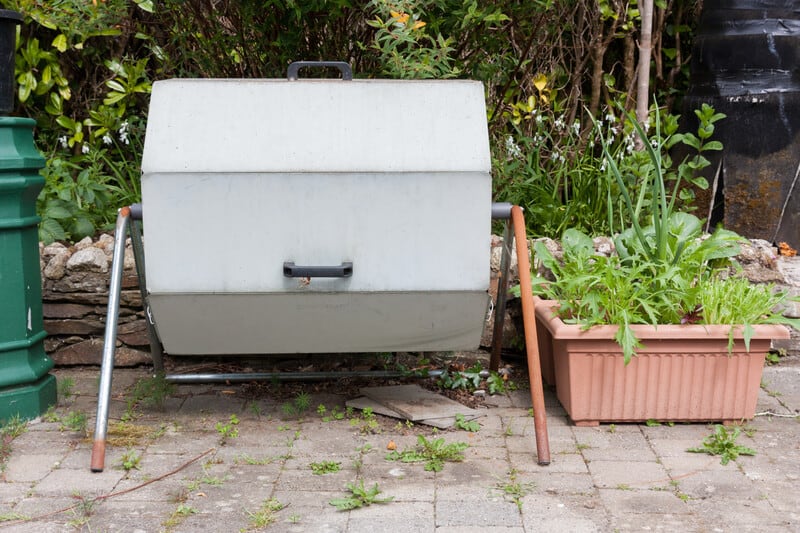
Tumblers are convenient to use because they retain the material well and make the turning fairly simple. The larger tumblers will create better end product more quickly, and there are a wide variety of designs available. Without a tumbler, you will need to manually turn the mixture.
Ideally, you'd begin with a layer of dried leaves and grass. If you only have access to green plant matter, you can shred and include newspaper in small pieces (as small as possible). As you layer your compost, you want a ratio of approximately 60 percent carbon (dry leaves, grass) to 40 percent nitrogen (green plant matter).
Good sources of carbon, also called “browns,” include:
- Untreated cardboard
- Straw
- Untreated wood chips
- Sawdust
- Dry twigs
- Paper towels
- Used animal bedding.
The bottom “brown” layer should be well aerated (fluffy) to prevent excess moisture from developing from the layers on top.
Upon the initial layer of carbon material, you want to add nitrogen-rich green plant matter. Good nitrogen-rich materials, also called “greens,” include:
- Cow and horse manure
- Garden trimmings
- Grass clippings
- Vegetable waste (carrot, cucumber, pear, apple, and potato skins, etc.).
The third, top layer should consist of soil and potting mix that doesn’t contain insecticides or synthetic fertilizers.
This mixture will begin to decay and decompose, breaking down and recycling organic matter into nutrient-rich compost. Check the compost pile regularly and stir it every few days, adding supplemental water when the interior of the pile begins to dry.
Although you can add a wide variety of things to your compost to create an excellent organic soil amendment, there are some items you do not want to add. These undesirable materials include:
- Dairy products
- Fat
- Meat
- Fish
- Dog or cat feces
- Doffee or tea bags
- Citrus peels or onions
- Coated paper products
- Coal ash
- Plant material with pesticides
- Plants with insect or disease infestation
Best Compost For Cannabis
What is the best compost for cannabis?
The greatest cannabis compost is well-aged, rich in organic materials, and nutrient-balanced. Look for these traits:
Dark, grainy, earthy-smelling compost is mature. No edibles or plants should be present. Due of its active microbial activity and heat creation, immature compost can injure plants.
Nitrogen, phosphorus, potassium, and other micronutrients must be balanced in cannabis. Good compost naturally contains these nutrients, but balance is crucial. Too much nitrogen might cause leaf growth over flowering.
Structure and Aeration: Compost should be light and airy. Good air exchange and water drainage are essential for root growth and health.
pH Balanced: Cannabis prefers 6.0–7.0 pH. Ideally, compost should be in this range.
Salt can damage cannabis plants. Avoid high salt levels in compost, especially manure-based compost.
Uncontaminated: Compost should not include pathogens, weed seeds, or residual pesticides or herbicides.
Types of Compost:
Homemade compost: Kitchen scraps, yard garbage, and other organic stuff. Management is needed to maintain balance and maturity, yet it's cheap and green.
Vermicompost: Produced by worm farming, it contains minerals and helpful bacteria. It's great for cannabis due to its delicate texture and balanced nutrients.
A nutrient-rich byproduct of mushroom farming, mushroom compost retains water. It may be alkaline and require pH correction.
Nutrient-rich composts are made from cow, horse, or chicken manures. Pathogens and nitrogen can be avoided by composting them.
The best compost for cannabis plants relies on their needs and growing circumstances. Mixing compost types or compost with various growing mediums can improve outcomes.
How to Use Compost
Compost differs from fertilizers. Compost is a soil amendment that enriches the soil and creates a beneficial environment for plants to grow. Fertilizers feed the plant more directly and may overload the soil with nutrients if you’re not mindful of signs of nutrient disorders.
Compost creates a richer, more balanced soil—and poor soil conditions are a main cause of poor plant health.
Compost does not replace fertilizers but creates excellent soils. It feeds the soil while fertilizers feed the plants more directly. A combination of both, sourced from organic material, provides optimum growing conditions.
Organic fertilizers trusted by the United States Department of Agriculture (USDA) organic farms, include products such as those sold by AgroThrive.
Compost is easy to use with outdoor cannabis grows by merely topping off the soil surrounding the plants. The amount you should use depends on the quality of the soil and its nutrient level. Topping the growing soil with compost in the fall will ensure a good growing environment in the spring.
“
There are over 300,000 jobs in the cannabis industry. CTU trained me for one of them!

Makes $24.50 @ THC +
An occasional topping of compost during the plant growth cycle will boost soil health and minimize the necessity of adding fertilizers on a frequent basis. Mixing compost with indoor plant soil is a great way to start your plants. Conservative topping of the soil periodically creates ideal growing conditions.
If you choose to use compost for your indoor or outdoor cannabis grow, you will likely notice a difference in overall plant vigor. Following harvest and a proper cure, the flavor and even burn of the finished product will be connoisseur quality.
If you haven’t tried compost when growing cannabis, by all means, give it a try. Very likely, it will be part of your cultivation protocol with all future grows.
Troubleshooting Compost Common Issues
Creating your own compost can be an easy way to improve your yield and quality. However, you may encounter a few composting challenges along the way. Here are the most common problem you may face and how to tackle them:
- Bad odor: If your compost smell starts to get considerably worse than more you may be suffering from a pile that has too many nitrogen-rich sources or one that is too moist. If this is the case, add more carbon-rich material. If your soil doesn’t have enough oxygen, turn it over to help aerate it.
- Too many flies and insects: Flies will naturally be attracted to your decomposing file, which won't harm your results which can be annoying. Try covering the pile with a layer of carbon-rich material.
- Too wet: Adding too much fresh material to your compost can increase the moisture content. Materials with a high water content can be heavier and make the pile more compacted than it needs to be, thereby, removing air spaces. Add dry materials to balance it out or turn the ingredients to aerate it.
- Too dry: Compost piles that are too dry can stop the decomposing process meaning your compost won't be as nutrient-rich and effective. Try watering the pile evenly, while mixing the material to ensure every part is evenly wet.
Growing Cannabis With Compost FAQ's
What are the signs of nutrient deficiency or excess in cannabis plants grown with compost?
Yellowing leaves, purple stems, and interveinal chlorosis suggest nutrient deficits. High nitrogen levels can generate black, claw-like leaves and burnt leaf tips. Based on these signals, compost and nutrient applications must be adjusted.
How do I prepare compost for growing weed?
To make cannabis compost, make sure it's totally decomposed and crumbly. Large chunks should be gone and it should smell neutral. Mixing compost with different soils in a 1:1 or 1:3 ratio improves aeration and drainage.
How much compost should I use for cannabis plants?
Strength and plant growth determine compost amount. Usually, 10-30% compost and soil work nicely. Potted plants need only a few inches of compost on top. Avoid over composting to avoid nutrient burn.
What are the benefits of using compost in cannabis cultivation?
Compost promotes soil structure, microbial life, and nutrient availability, promoting plant development. It retains water and releases nutrients slowly.
Learn to Cultivate Cannabis at the Leading Cannabis University
Are you looking for an online cannabis university to learn how to effectively fertilize your cannabis plants? Do you want to optimize your indoor and outdoor garden?
Whether you want to prepare for a job in the cannabis industry’s cultivation sector or simply improve your home grow, Cannabis Training University will help you succeed.
Enroll in one of our online marijuana training courses to become a cannabis growing expert today!

Luis Cordova
Luis Cordova is a distinguished author, and renowned expert in cannabis cultivation, who possesses a Master's degree in Plant Biotechnology and Pharmaceutical Science. As a valued contributor to highly esteemed publications such as Cannabis Training University and Maximum Yield Magazine, Luis has emerged as a trusted source of guidance and knowledge in the cannabis industry. Having written thousands of informative articles, Luis is widely recognized for his comprehensive expertise on cultivating cannabis, both indoors and outdoors.


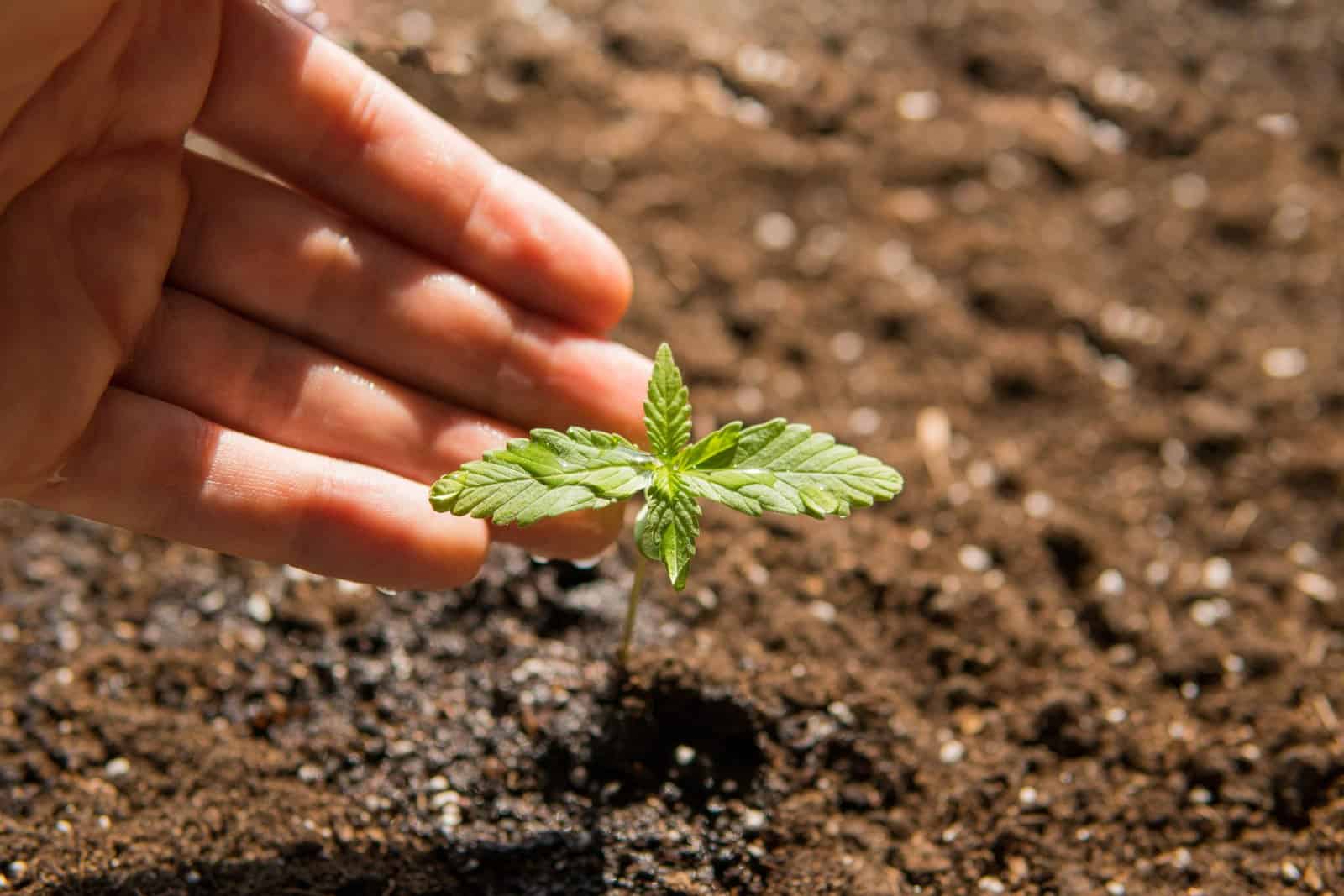





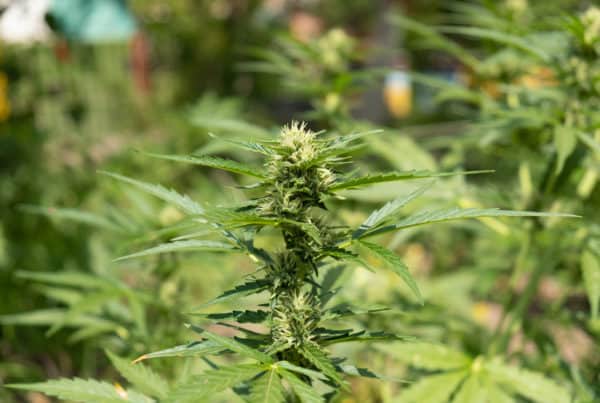



 Jeff was involved in an accident where he endured a traumatic brain injury. He had a week-long stay in ICU where brain surgeons
Jeff was involved in an accident where he endured a traumatic brain injury. He had a week-long stay in ICU where brain surgeons  100% risk free money back guarantee within 48 hours after purchase if student has not completed any of the courses or exams.
100% risk free money back guarantee within 48 hours after purchase if student has not completed any of the courses or exams.